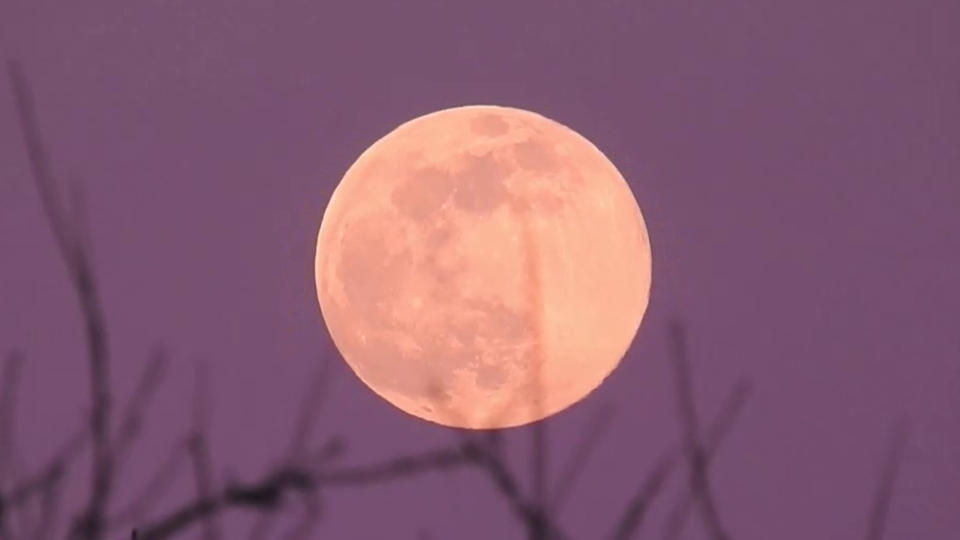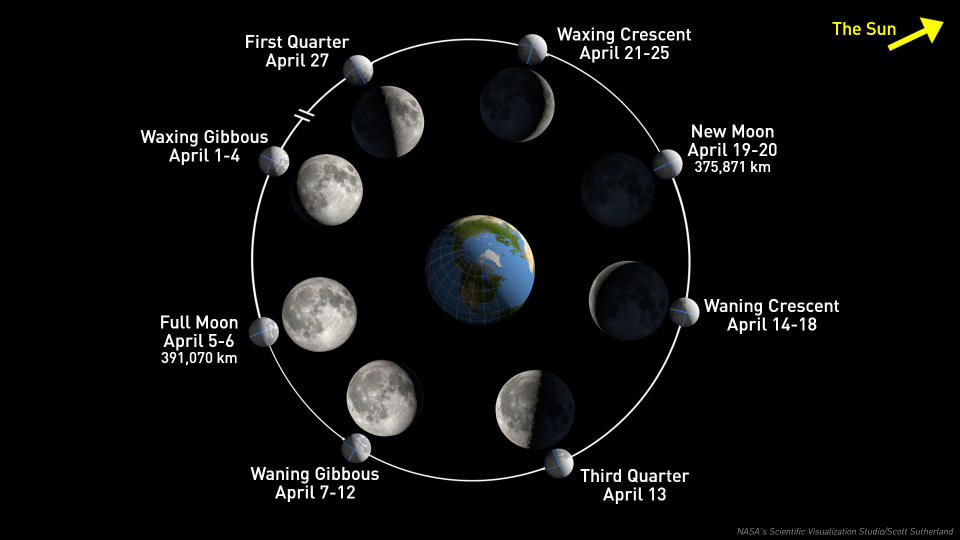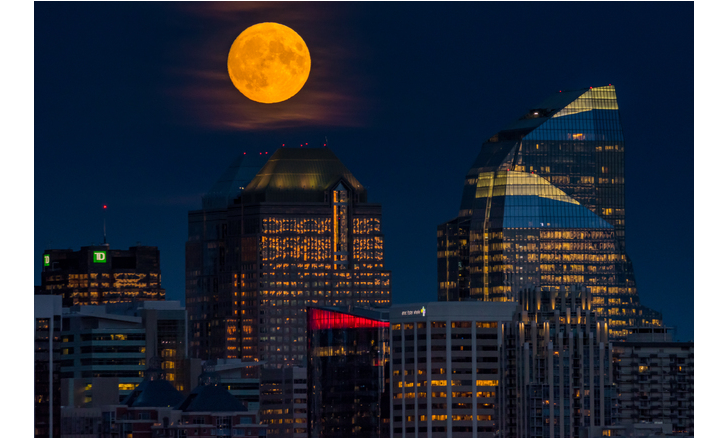Look up this week to see April's Full Pink Moon shine in the sky

The first Full Moon of Spring rises on Wednesday night.
April's Full Moon — the Full Pink Moon — shines in the sky this week. Although astronomical calendars have the event timed for exactly 12:35 a.m. EDT on Wednesday, April 6, according to NASA, the Moon will appear full from Tuesday evening through Friday morning.
Visit our Complete Guide to Spring 2023 for an in-depth look at the Spring Forecast, tips for planning for it and much more!
What is a Pink Moon?
Each Full Moon of the year goes by a set of names, chosen by the Farmer's Almanac close to a century ago. The popular name of the April Full Moon is the Pink Moon.

This graphic collects all the relevant data about each Full Moon of 2023, including their popular names, whether they are a 'super' or 'micro' Moon, a perigee or apogee Full Moon, and whether they are remarkable in some other way, such as a Blue Moon, Harvest Moon or a lunar eclipse. Credit: NASA's Scientific Visualization Studio/Scott Sutherland
These names were taken from Colonial and European folklore, as well as the lunar calendars of First Nations peoples living in the US Northeast.
The Pink Moon isn't named for the Moon's colour. Instead, The Old Farmer's Almanac says this Full Moon gets its name from a plant named wild ground phlox, or "pink moss", which is one of the first spring wildflowers that bloom in the US Northeast at this time of year.
Other names they list include Sprouting Grass Moon, Hare Moon, Fish Moon (for when American shad would leave the Atlantic Ocean to swim upstream along freshwater rivers to spawn), and Egg Moon (an Old English/Anglo-Saxon name).
However, there are many First Nations peoples that live throughout North America, each with their own language, and their own names for the Moons of the year.
It's important to note that these names are not specifically for the Full Moon alone. Many First Nations peoples tracked the year using a lunar calendar. A moon name, therefore, referred both to the Full Moon and the roughly 29-day period ('lunation') between then and the next Full Moon.
According to Western Washington University's Spanel Planetarium, many First Nations tribes had names for the April Full Moon, or the lunar month associated with the April Full Moon.
Some named it after the timing of when plants were known to bud or flower (Apache, Cherokee, Mohawk, Sioux, and Tlingit), or when they harvested things such as maple sap (Abenaki and Anishinaabeg) and blackberries (Choctaw), or when they planted maize (Algonquin and Winnebago). Others named them after the general seasonal trends of spring (Comanche, Creek, Passamaquoddy, Shoshone, and Zuni), or the hardships endured when food was scarce (Lakota and Kalapuya).
Read: Canadian astronaut Jeremy Hansen chosen to fly around the Moon on Artemis 2
Will the Moon turn pink?
Regardless of its popular name, when you gaze up at the Moon on Wednesday night, it likely won't be pink.
However, if you watch the Moon as it's rising or setting, there's a chance you may catch a slight tinge of pink due to a phenomenon known as the Belt of Venus.
The Belt of Venus appears in the east just after sunset or in the west just before sunrise, most often during clear, calm weather. It shows up as a band of pink just above a band of grey-blue near the horizon. The pink colour is caused by tiny particles in the air reflecting back the colours of the setting or rising Sun, while the dark grey-blue is the result of Earth's shadow.

This pink-tinged Full Moon was captured from Eskasoni, Nova Scotia on April 7, 2020. Credit: Riki Christmas/UGC
However, when the Moon is high in the sky, it will appear in the same shades of grey it usually does. To see the Moon actually change colour, we'll have to wait until March 2025, when the next Total Lunar Eclipse shines in the sky.
Read: Here's what NASA astronauts will be wearing on the Moon
Biggest & brightest of 2023, so far
It's challenging to notice how each Full Moon's apparent size changes from month to month, or even how the Moon's size changes as it cycles through its phases during any single month. Still, if the Full Pink Moon looks a bit bigger than the others we've seen so far this year, that's because it actually does.
As the Moon travels around Earth, its orbit isn't a perfect circle. Due to the gravitational pull of the Sun and the other planets in the solar system, it instead traces out a slightly elliptical path.

The Moon's orbit and phases during April 2023. While astronomers observe the First Quarter, Full Moon, Third Quarter, and New Moon on one specific night/day each, the Waxing Crescent, Waxing Gibbous, Waning Gibbous and Waning Crescent phases last for several nights each. Credit: NASA's Scientific Visualization Studio/Scott Sutherland
This elliptical orbit results in a yearly cycle for Full Moons. One among them is the farthest and smallest of the year — the 'apogee micromoon'. In 2023, it was February's Full Snow Moon. After that, each Full Moon appears larger and brighter until we see the closest and largest of the year — the 'perigee supermoon'. This will be the Full Blue Moon which occurs on the night of August 30. Then, the Full Moons will appear smaller and dimmer until the next apogee micromoon (Feb. 2024).
Read: Planets dance amid eclipses and meteor showers this spring. Don't miss out!
The Magnificent Moon Illusion
However, there can be an imaginary component to how big the Moon appears. If you look up at it just after moonrise or just before moonset it can seem exceptionally big, due to a little trick of our mind known as The Moon Illusion.
As we observe the world around us, our brain knows from experience that objects close-by tend to appear larger and in focus. In contrast, distant objects are usually tiny and blurry. By bridging the gap between these two concepts, the brain therefore "knows" that for a distant object to appear in focus, it must be very large.

This close-up of the Harvest Moon was snapped in Calgary, AB, on September 13, 2019. Credit: Siv Heang
So, when we see a bright Full Moon hanging in the sky above the horizon — crisp and clear and in focus — while at the same time, all of the objects on the ground become smaller and blurrier the closer they are to the horizon, the combination leaves us standing on that aforementioned bridge that the brain has built.
To compensate, the brain interprets the Full Moon as being much bigger than it truly is. To be clear, at 3,474 km across, the Moon is certainly much larger than any of the objects on the horizon. However, the illusion makes the Moon appear huge!
Look up into the sky closer to the middle of the night, and the Moon will be high above our heads. Usually, it will be the only thing we see, other than the stars and maybe a few planets. At that time, the brain is focused only on the Moon, and without the other objects in the field of view to complicate matters, it is free to just see its actual size.

This zoomed-in image of the Full Snow Moon was captured from Salisbury, NB, on February 9, 2020, and uploaded into the Weather Network's UGC gallery. Credit: Darlene MacLeod/Smith
It's quite challenging to see past this illusion. There are a couple of tricks that can help cancel it out, though.
For the first one, just go outside after sunset and find the Moon near the horizon. Stretch your arm out towards it, and cover the Moon over with the tip of a finger or thumb (whichever is closest to the size of the Moon). Note how big the Moon looks compared to the digit in question, and keep that in mind. Maybe even take a picture of it, if you want. Later in the night, check out the Moon again when it's high in the sky. It may appear smaller than when you saw it earlier, but repeat what you did earlier, and cover it over with your finger or thumb. Compare it with what you saw before, and you'll find that the Moon is actually precisely the same size at both times.
There is a way technology can help us, though. When the Moon is low on the horizon, take out your cell phone, turn your camera on, and point it at the Moon. Note: it is possible for the Moon illusion to still work on us when looking at a picture or video. This is because the brain will make the same judgments of distance, blurriness, and size as it did when looking at a 'live' scene. Still, directly comparing what we see in the sky at that time to what is shown on our small cell phone screen can help put things into better perspective. Plus, you can also take a few pictures to upload into the Weather Network UGC Gallery while you're at it!
Thumbnail image and video courtesy Riki Christmas, who captured a rare pink Full Pink Moon from Eskasoni, Nova Scotia, on April 7, 2020.

